About
Special News
Logan's Page
Jacoby's Page
Our Travel Index
Tracks Ahead Related Trips
Contact
Baltic Countries Cruise - 2010
Demark, Sweden, Finland, Russia, Estonia, Poland, Norway
 |
Our home away from home, the Star Princess, of the Princess Cruise Line fleet. Just the eleven of us and 2,589 of our other closest personal friends! Unpack once, and you're good to go! |
May 10/11
We were off to the airport in Milwaukee right on schedule at 7 AM.
We both actually slept the previous night. Despite the traffic
construction, we got to the airport on time and met with Bill & Jane
Martin. The flight to Atlanta was uneventful. Our flight out
of ATL was delayed from 6:15 to 8:20, so Barb and I abandoned the group
and used our limited Delta Sky Pass to get
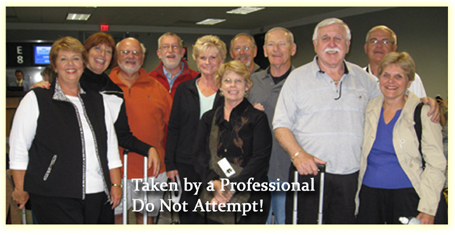 into
the Sky club in the terminal. So we had quiet, free snacks and
drinks. I really could get used to this sort of waiting for the
plane!
into
the Sky club in the terminal. So we had quiet, free snacks and
drinks. I really could get used to this sort of waiting for the
plane!
While we were waiting at the gate, we wanted a group photo - a sort of
"before" picture. A young man was standing off to the side, and we
asked him to take the shot. It turns out he is one of the Star
Princess photographers. So we had a pro take the picture! He
was heading back to the ship after some vacation time. I am
certain we will see him later.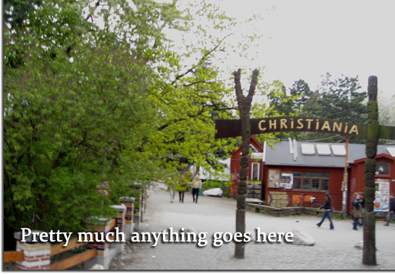
The plane left at 8:20, due to the ash cloud from Iceland. So while we slept a bit on the flight, it was the usual cattle call, arriving in CPH at 11:45 on the 11th. We got to the hotel, checked in, and set out to perform a brief exploration of Copenhagen. We decided on the Hop On, Hop Off tour, as the ticket would still be good for the next day. So we got a brief overview of the city. Built on a bunch of islands, Copenhagen is loaded with a mix of old and new, as is most of Europe. Of some interest is the area of Christiana which is a sort of commune in the middle of town. It has it's own laws, and has a somewhat controversial status within Copenhagen.
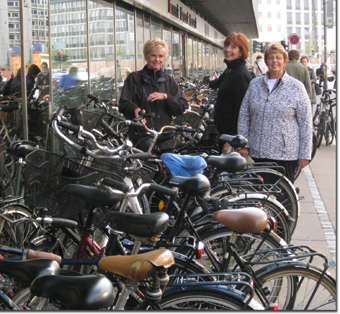
One thing visitors have to look out for are the bicycles. In 1973, as a result of the oil crisis, bicycles pretty much took over here, and there are more of them than automobiles.
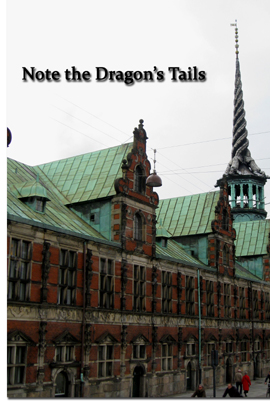
So we saw some of the old castles and buildings, including the original stock exchange, which featured a tower of twisted dragon's tails. Somehow, in today's economy, that seems apropos. We ended up in a bar that – of all things – replicated the American Southwest. Go figure! After a visit to the train station, we headed for bed.
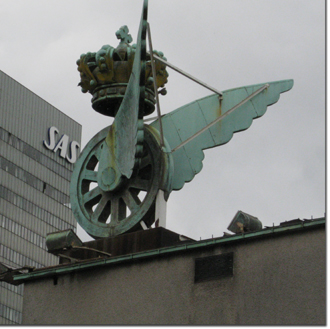
How nice that the hotel is right next to the railway station.
May 12
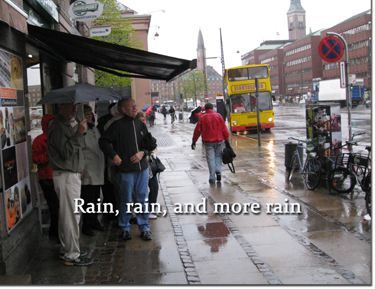 Today
it rained. Like, it really rained. The shop keeper under
whose awning we stood was not happy. Not that he was likely to
have many customers in the driving downpour!
Today
it rained. Like, it really rained. The shop keeper under
whose awning we stood was not happy. Not that he was likely to
have many customers in the driving downpour!
Undaunted, we headed out to the Hop On, Hop Off bus station and waited for the bus. The plan was to go to the Rosenborg Castle.
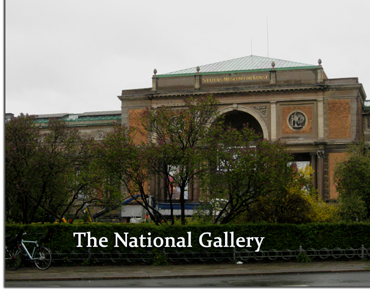
Four of us – Barb and I included – ended up at the National Gallery. And of course, we got soaked in the process. The rest of the group made the correct choice and got to the castle without getting too drenched.
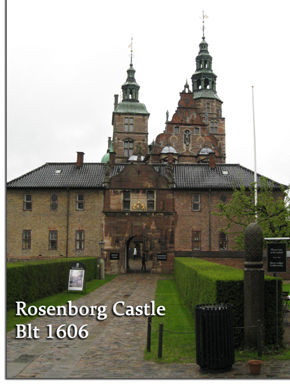
We intrepid four eventually did get to the castle, and it was wonderful.
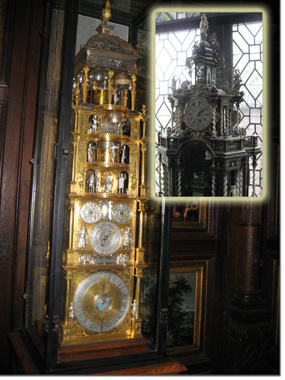
There were plenty of tapestries, furniture, and period items to see, as well as the thrones of the Danish kings of old. Of particular note were the antique clocks, paintings,
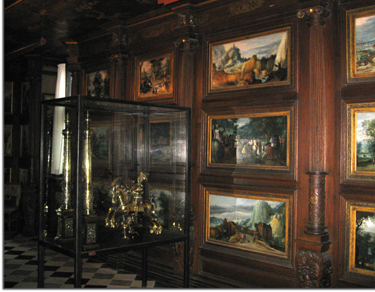
as well as the throne room, complete with guarding lions.
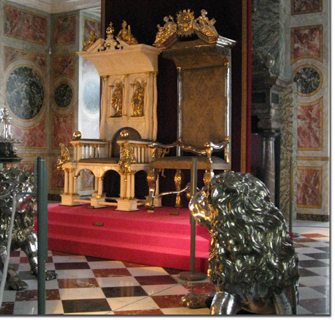
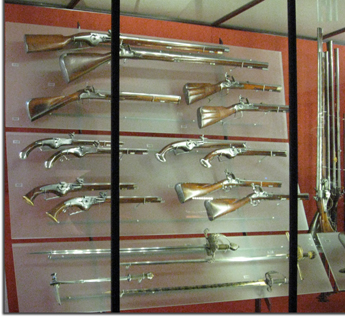
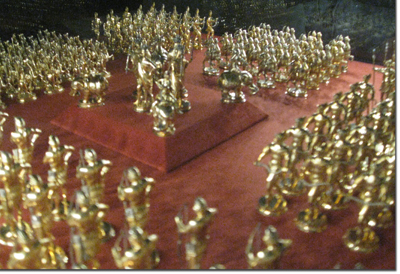 This
tour also included the treasury, which has a plethora of priceless
firearms and jewels. One of the displays was a cast gold army.
This
tour also included the treasury, which has a plethora of priceless
firearms and jewels. One of the displays was a cast gold army.
We lucked out on the return trip, and except for the horrible traffic, got back to the hotel in time for Ivan, our cab driver to get us to the ship. We boarded with no difficulties, got unpacked, went through the mandatory life vest drill, and headed out for – where else, the bar. The Eating Contest commenced with a dinner for the 11 of us. As is customary on these cruises, the staff is from all over the world. So the server was a personable young man named Pato, from Chile, while his assistant, Leticia, hailed from Uruguay. After dinner we went to the live show in the Princess Theater, which of course, is basically an ad for Princess services, but did feature some song and dance, as well as a ventriloquist. Then off to explore the ship, along with the rest of our 2,600 closest personal friends. The evening ended up at SkyWalkers, a sort of flying bridge at the stern and the top-most bar. While the rest of the party went on to karaoke night, I went to bed. Tomorrow we are technically “at sea.” Read that as traveling to Stockholm.
May 13
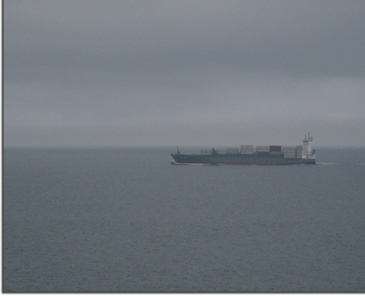 Today
was a transit day, as we made our way out of the Copenhagen area and up
the Baltic Sea toward Stockholm. This morning I went to a lecture about
the city, so I would be a bit more familiar with what was to come.
Seating is always a bit of a dart toss at lunch, so seating is usually
European style; i.e., sit at any open seats, no matter that the rest of
a table is occupied. Plus it is a great way to meet people. Our
initial table companion obviously did not get the message on this as he
was a true Mr. Cranky Pants. His wife, on the other hand was nice, and
the three of us chatted for a bit. I hope this guy lightens up, or it
will be along ten days for him. A portion of the afternoon was spent in
an intermediate Photoshop class. The software was Photoshop Elements,
sort of a stripped down version of the regular version. I did pick up
some tips, which is what I wanted. As for the day,
Today
was a transit day, as we made our way out of the Copenhagen area and up
the Baltic Sea toward Stockholm. This morning I went to a lecture about
the city, so I would be a bit more familiar with what was to come.
Seating is always a bit of a dart toss at lunch, so seating is usually
European style; i.e., sit at any open seats, no matter that the rest of
a table is occupied. Plus it is a great way to meet people. Our
initial table companion obviously did not get the message on this as he
was a true Mr. Cranky Pants. His wife, on the other hand was nice, and
the three of us chatted for a bit. I hope this guy lightens up, or it
will be along ten days for him. A portion of the afternoon was spent in
an intermediate Photoshop class. The software was Photoshop Elements,
sort of a stripped down version of the regular version. I did pick up
some tips, which is what I wanted. As for the day,
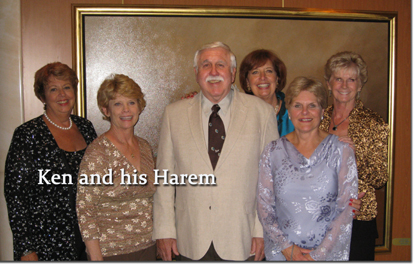 it
was spent mainly looking at water. Dinner is formal, which means I have
to (gasp) wear a tie. Dinner was the usual rollicking time.
Afterwards, we missed the early show, so we hung out in a bar, listened
to some music, and I blew $10 on the penny slots. Last of the big time
spenders. The late show was a musical extravaganza. If you ever
wondered how you could work “Doing the Time Warp Again” into a
production, this was it. The show was called Destinations, and was an
excuse for lavish costumes, set changes, and high energy music. I must
admit I drifted at one point, but it was a fun time. Off to bed.
Tomorrow we are in Sweden.
it
was spent mainly looking at water. Dinner is formal, which means I have
to (gasp) wear a tie. Dinner was the usual rollicking time.
Afterwards, we missed the early show, so we hung out in a bar, listened
to some music, and I blew $10 on the penny slots. Last of the big time
spenders. The late show was a musical extravaganza. If you ever
wondered how you could work “Doing the Time Warp Again” into a
production, this was it. The show was called Destinations, and was an
excuse for lavish costumes, set changes, and high energy music. I must
admit I drifted at one point, but it was a fun time. Off to bed.
Tomorrow we are in Sweden.
May 14
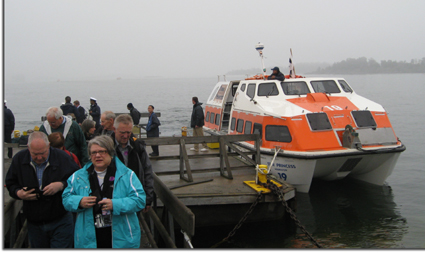 Overnight,
the fog rolled in. Warm air flowing south from the Gulf of Finland
produced thick billowing fog conditions, halting the ship at the
original docking area in Nynashemn, where we stood off, and tendered in
to the shore. It was about a 50 km drive into Stockholm, so we
were glad we decided on a ship shore package, rather than trying to do a
tour on our own. The buses picked us up, and we drove through land
that closely resembled Wisconsin and
Overnight,
the fog rolled in. Warm air flowing south from the Gulf of Finland
produced thick billowing fog conditions, halting the ship at the
original docking area in Nynashemn, where we stood off, and tendered in
to the shore. It was about a 50 km drive into Stockholm, so we
were glad we decided on a ship shore package, rather than trying to do a
tour on our own. The buses picked us up, and we drove through land
that closely resembled Wisconsin and
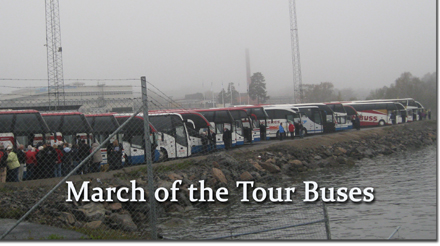 Northern
Michigan. It is easy to see why so many Scandinavian immigrants
settled in the Great Lakes region, as that area closely resembles their
homelands. We did a brief bus tour of the old town of Stockholm
(the Gamla Stan). Sweden has an archipelago, and like Copenhagen,
Stockholm is also built on a number of major islands. It is a
clean, nice looking city,
Northern
Michigan. It is easy to see why so many Scandinavian immigrants
settled in the Great Lakes region, as that area closely resembles their
homelands. We did a brief bus tour of the old town of Stockholm
(the Gamla Stan). Sweden has an archipelago, and like Copenhagen,
Stockholm is also built on a number of major islands. It is a
clean, nice looking city,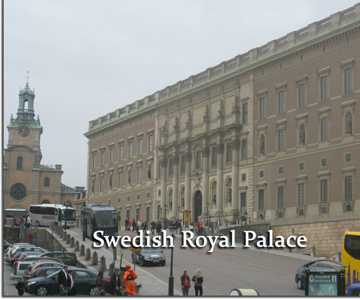 with a combination of old and new, as is much of Europe (that hasn’t
been bombed to rumble at some point in the last century.) The
original Vikings came from the Scandinavian countries, although which
ones in terms of modern state lines is a bit indeterminate. They
did have a great deal to do with the settling of Europe, founded the
first Russian State, and their rule spanned to a wide, diverse part of
the continent. We passed the parliament, the royal palace (where
the monarchy does not live), as well as other important government
buildings. We continued to our first stop at a small, old town
called
with a combination of old and new, as is much of Europe (that hasn’t
been bombed to rumble at some point in the last century.) The
original Vikings came from the Scandinavian countries, although which
ones in terms of modern state lines is a bit indeterminate. They
did have a great deal to do with the settling of Europe, founded the
first Russian State, and their rule spanned to a wide, diverse part of
the continent. We passed the parliament, the royal palace (where
the monarchy does not live), as well as other important government
buildings. We continued to our first stop at a small, old town
called
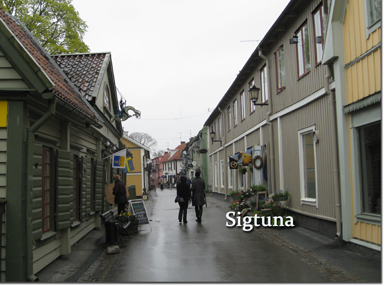 Sigtuna.
As it started to rain yet again, and as our only working umbrella got
trashed in the Danish wind, we bought new bumbershoots and had a short
lunch in a delightful, local cafe. Mostly this was an example of a
small, old quiet town, with a ruined church, red painted wooden houses,
rune stones, and the oldest brick church in Sweden. The king and
his ministers had residences here and it is considered to be Sweden’s
first city (970 AD). Apparently, the layout has not changed much
from that time.
Sigtuna.
As it started to rain yet again, and as our only working umbrella got
trashed in the Danish wind, we bought new bumbershoots and had a short
lunch in a delightful, local cafe. Mostly this was an example of a
small, old quiet town, with a ruined church, red painted wooden houses,
rune stones, and the oldest brick church in Sweden. The king and
his ministers had residences here and it is considered to be Sweden’s
first city (970 AD). Apparently, the layout has not changed much
from that time.
Our visit to Sigtuna complete,
we went back into Stockholm to the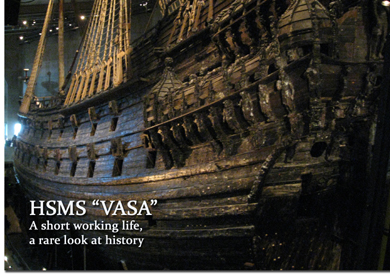 Vasa Museum. The Vasa is a Swedish warship, built in the 1600s.
Once the ship was almost completed, the king decided he wanted a “really
big ship.” And so he ordered an additional gun deck placed on the
top of the ship. It was pointed out that this would make the ship
Vasa Museum. The Vasa is a Swedish warship, built in the 1600s.
Once the ship was almost completed, the king decided he wanted a “really
big ship.” And so he ordered an additional gun deck placed on the
top of the ship. It was pointed out that this would make the ship
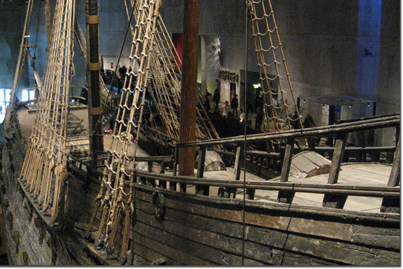 unstable,
but the king said, “I’m the king. Do it!” The gun deck was
added. The ship was launched, outfitted, and set off on its
inaugural sail. Filled with dignitaries and families, the sails
were raised. They caught the breeze, and the rest is history, as
the top heavy craft foundered on this maiden voyage. In fact, it
never left the harbor. The masts were cut off, and the wreck was
promptly forgotten. But at
unstable,
but the king said, “I’m the king. Do it!” The gun deck was
added. The ship was launched, outfitted, and set off on its
inaugural sail. Filled with dignitaries and families, the sails
were raised. They caught the breeze, and the rest is history, as
the top heavy craft foundered on this maiden voyage. In fact, it
never left the harbor. The masts were cut off, and the wreck was
promptly forgotten. But at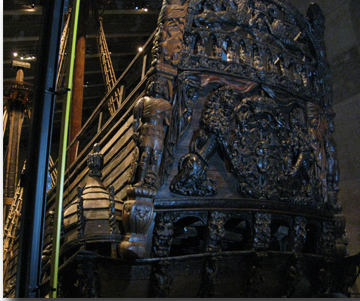 this point, good fortune for future historians intervened. The
ship settled in brackish water, due to the mixing of the cold Baltic Sea
and the outflow of a large local river or lake. So the ship never
deteriorated, as the water was not saline enough for sea worms to live.
The ship was rediscovered in 1961, and cables were driven under the
hull. Two submersible barges were used to raise the ship to the
light of day. It was drenched with clear water and ethylene
polyglycol for 17 years, and placed in an enclosed museum where she
resides today. The ship is
this point, good fortune for future historians intervened. The
ship settled in brackish water, due to the mixing of the cold Baltic Sea
and the outflow of a large local river or lake. So the ship never
deteriorated, as the water was not saline enough for sea worms to live.
The ship was rediscovered in 1961, and cables were driven under the
hull. Two submersible barges were used to raise the ship to the
light of day. It was drenched with clear water and ethylene
polyglycol for 17 years, and placed in an enclosed museum where she
resides today. The ship is
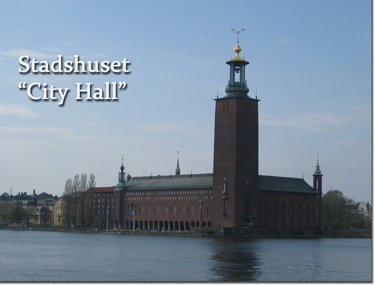 an
amazing example of preservation. The ornate carvings are
remarkably intact. Also on display are over 20,000 artifacts, and
some skeletons from the sinking. This is a must see stop if you
are ever in Stockholm. I must tell you about tour buses. I
am lulled to sleep almost instantly. Today was no exception.
But we were back to the ship by 5:30. The party continues.
Later. We tried a new restaurant tonight, but were less than
impressed with the service. Tomorrow we will return to our
original spot and friendly servers and staff.
an
amazing example of preservation. The ornate carvings are
remarkably intact. Also on display are over 20,000 artifacts, and
some skeletons from the sinking. This is a must see stop if you
are ever in Stockholm. I must tell you about tour buses. I
am lulled to sleep almost instantly. Today was no exception.
But we were back to the ship by 5:30. The party continues.
Later. We tried a new restaurant tonight, but were less than
impressed with the service. Tomorrow we will return to our
original spot and friendly servers and staff.
May 15
Overnight we escaped the fog and rain and greeted the day with clear
blue skies and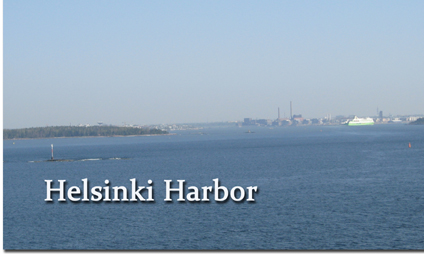 temperatures around 18 (upper 60’s). Around 10 AM we docked in
Helsinki, the capitol of Finland. I must admit that my memory
and/or knowledge of the Baltic countries is less than complete. I
did not realize that Finland was a part of Russia. At the end of
the Napoleonic Wars in the early 19th century, Finland passed
from Sweden to Russia by treaty. The Russians were delighted to
gain so much seacoast, and built Helsinki. During the Bolshevik
Revolution, Finland declared its independence. The Russians were a
bit busy internally, so the break away move went unchallenged, and
Finland has remained independent ever since. In 1939-40, Finland
was forced into war (and sided with the Germans) against Russian
annexation. They were lead by a Marshal Gustav Mannheim, who was
instrumental in maintaining Finland’s independence. Our tour today
was short, as we only drove past the major buildings, through
temperatures around 18 (upper 60’s). Around 10 AM we docked in
Helsinki, the capitol of Finland. I must admit that my memory
and/or knowledge of the Baltic countries is less than complete. I
did not realize that Finland was a part of Russia. At the end of
the Napoleonic Wars in the early 19th century, Finland passed
from Sweden to Russia by treaty. The Russians were delighted to
gain so much seacoast, and built Helsinki. During the Bolshevik
Revolution, Finland declared its independence. The Russians were a
bit busy internally, so the break away move went unchallenged, and
Finland has remained independent ever since. In 1939-40, Finland
was forced into war (and sided with the Germans) against Russian
annexation. They were lead by a Marshal Gustav Mannheim, who was
instrumental in maintaining Finland’s independence. Our tour today
was short, as we only drove past the major buildings, through
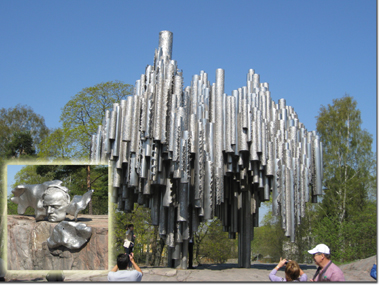 downtown,
although we made several stops. The first was at the Sibelius
Monument, which was rather bizarre. I think the idea was to have
an artistic display of organ pipes, but the result is a bit strange.
The appearance, coupled with the fact the things made some odd sounds as
the winter winds blow over them, caused another display to be erected.
It too, is a little strange.
downtown,
although we made several stops. The first was at the Sibelius
Monument, which was rather bizarre. I think the idea was to have
an artistic display of organ pipes, but the result is a bit strange.
The appearance, coupled with the fact the things made some odd sounds as
the winter winds blow over them, caused another display to be erected.
It too, is a little strange.
What was not strange,
was the idyllic setting of the monument. It is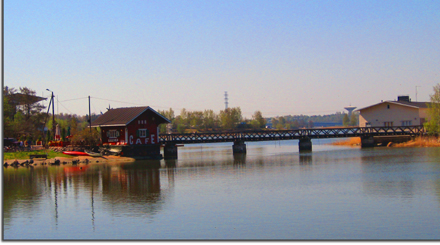 in a quiet city park, right across the road from a picturesque house and
bridge.
in a quiet city park, right across the road from a picturesque house and
bridge.
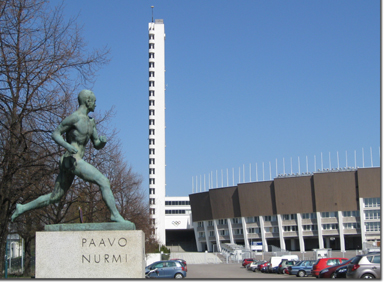
We did a brief photo op at the site of the Olympic Stadium. This
was supposed to house the 1940 Olympics, but the war forced a
postponement until 1952. The big attraction was Paavo Nurmi, a
local long distance runner, who came through for the hometown with a
bunch of gold and silver medals. We passed the opera house, named
Findlandia, because of Sibelius’s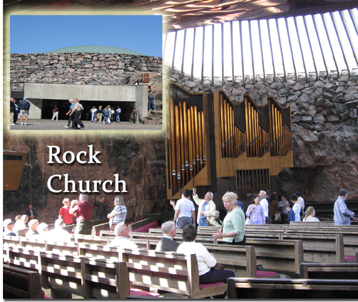 composition.
composition.
The next stop was the Temppeliaukio Rock Church. This Lutheran Church (90% of all Finns are Lutheran) was blasted into the granite bedrock of the city, and domed with copper strips. It is quite striking, with a wonderful pipe organ.
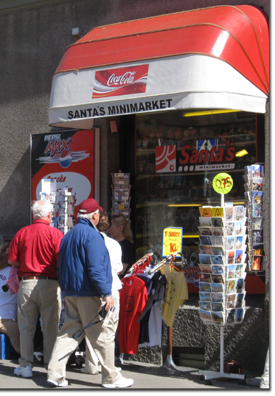 And
apparently, Santa lives here, because his shop was right across the
street!
And
apparently, Santa lives here, because his shop was right across the
street!
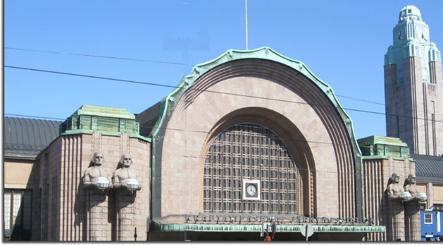
The final stop was the main plaza. As today was Saturday, there were plenty of people out and about. Streetcars abound, and are linked to the main train station, which was designed by Eron Saarinen in 1909 or something. It is pretty well known for its four figures holding world globes at the main entrance.
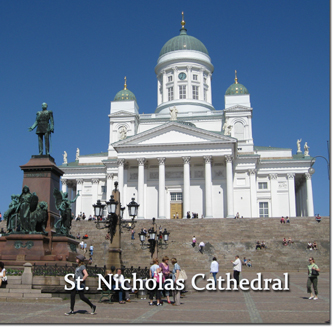
Senate Square is dominated by the Lutheran Cathedral of St. Nicholas. Surrounded by tourists, it is an imposing structure on the skyline.
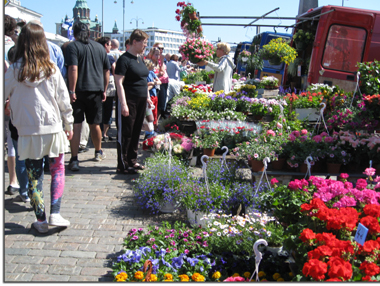
The market area is just a short distance away, and there were the usual street performers and musicians that are found all over the world at places such as this. We got back to the ship early, and will try to rest up for the next two days. They promise to be hectic.
May 16
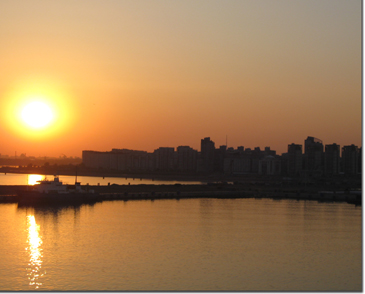 Today
was our first day in St. Petersburg, and it started at 5:30 AM, as we
had to get ready to leave the ship and hook up with a private tour guide
at 7:30. St. Petersburg looked the same as when we were here
previously, only with less building scaffolding. Our guide and
driver, Elena and Yuri, respectively, were knowledgeable and well versed
in the handling of American tourists. When asked what they had
done in Soviet times, Yuri wouldn't tell us (I read that as military)
and Elena was satellite communications engineer. They now make
more guiding tourists than they did in their original professions.
This was in line with what we had learned from others in our previous
visit.
Today
was our first day in St. Petersburg, and it started at 5:30 AM, as we
had to get ready to leave the ship and hook up with a private tour guide
at 7:30. St. Petersburg looked the same as when we were here
previously, only with less building scaffolding. Our guide and
driver, Elena and Yuri, respectively, were knowledgeable and well versed
in the handling of American tourists. When asked what they had
done in Soviet times, Yuri wouldn't tell us (I read that as military)
and Elena was satellite communications engineer. They now make
more guiding tourists than they did in their original professions.
This was in line with what we had learned from others in our previous
visit.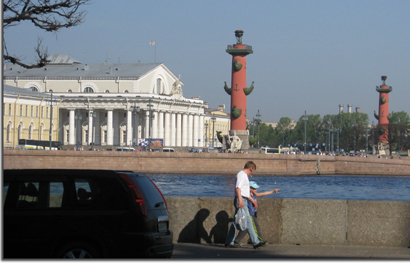
First up was a basic drive around, showing the old maritime Rustral Columns, and the former stock exchange, as well as a stop to see a nunnery established by someone whose name escapes me.
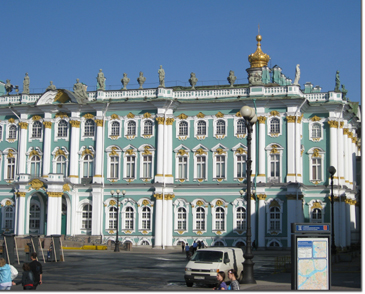
This was all designed to kill time before we could get into the
Hermitage. We did the usual walk through a portion of the
priceless art collection. I must say, that after a short time, I
do get a bit tired of looking at religious pictures, no matter if the
painter was a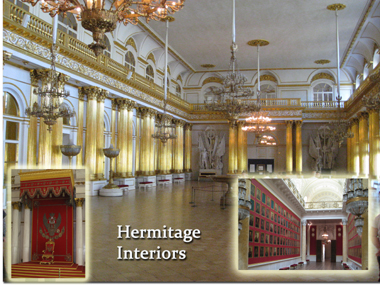 famous master or not.
famous master or not.
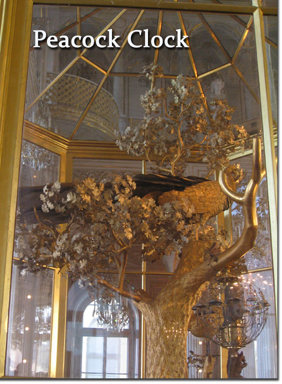
I
am still fascinated with the Peacock Clock.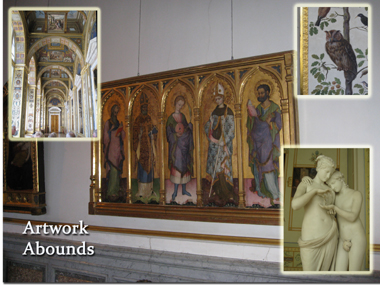
And the artwork just goes on and on.

And there are usually other items of interest, which some would definitely put in the "art" category!
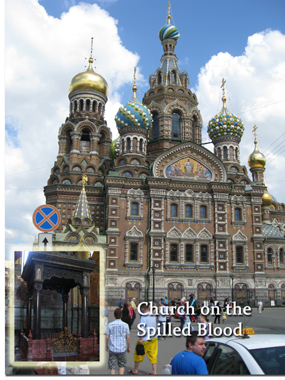
We stopped to take a few photos of the Winter Palace, and then it was off to lunch at a local restaurant. Then we were on to the Church on the Spilled Blood, which was constructed on the site where Alexander the 2nd was assassinated. Used as a storage facility in Soviet times, it and all its mosaics have been breathtakingly restored to the original condition. The colors and magnificence are astounding.
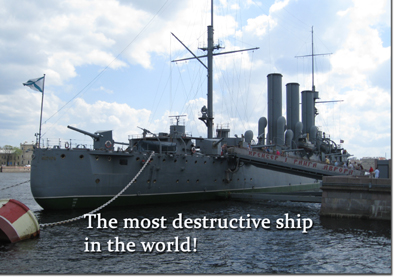 Finally
it was time for
my highlight – a visit to the cruiser Aurora. The Russians say
that this was the most destructive ship in the entire navy. One
shot in 1917 started the revolution that caused so much death and
destruction for 70 years. The ship is a monument, and of course,
in immaculate condition. While a crew still lives on her, she is
primarily used as a floating exhibit and tribute to the start of the
Soviet times.
Finally
it was time for
my highlight – a visit to the cruiser Aurora. The Russians say
that this was the most destructive ship in the entire navy. One
shot in 1917 started the revolution that caused so much death and
destruction for 70 years. The ship is a monument, and of course,
in immaculate condition. While a crew still lives on her, she is
primarily used as a floating exhibit and tribute to the start of the
Soviet times. 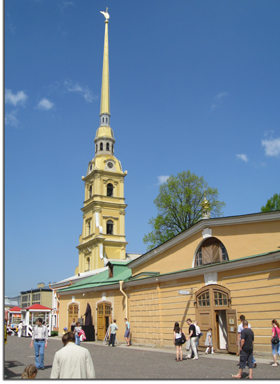 It was at this stop that one of our party almost had his pocket picked!
That's the first time for us since the time on the London Tube years
ago. Next stop was the Peter & Paul Fortress. Built on an
island to protect the approaches to the city, it ended up really only
serving as a prison and symbolic fort. It is the burial place to
the rulers, including the last of the Romanovs.
It was at this stop that one of our party almost had his pocket picked!
That's the first time for us since the time on the London Tube years
ago. Next stop was the Peter & Paul Fortress. Built on an
island to protect the approaches to the city, it ended up really only
serving as a prison and symbolic fort. It is the burial place to
the rulers, including the last of the Romanovs.
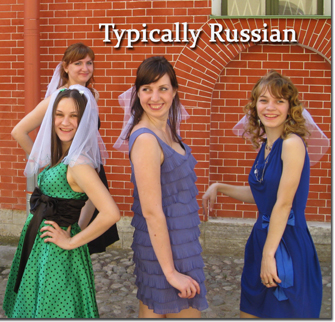
And some typical Russians sights again presented themselves.
Next stop was the Yusopov Palace. The Yusopov’s were a wealthy
noble family (boyars) at the end of the 19th century, tracing
their heritage back to Genghis Khan. The reception and living
quarters were breathtaking, as only the opulence of the Russian nobility
can display. This was also the place where Rasputin, the mystic
and consultant to Czarina Alexandra was killed. He was poisoned,
shot twice, and eventually drowned in the Neva. The Yusopov’s were
either exiled or forced out of the country, which was fortunate for
them, and the Revolution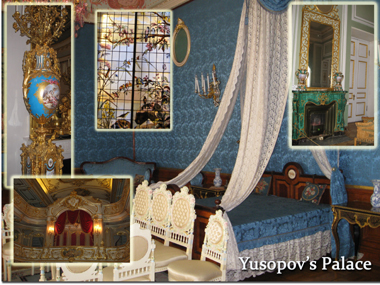 occurred shortly after this event. We were pretty tired by this
point, but forged on to what is probably the most impressive cathedral
in Russia, St. Isaacs. It also escaped major damage in the WW2,
and has been restored to its original glory. The sights of these
things are simply stunning. St. Petersburg hasn’t changed much
since we were here 5 years ago. There is still a lot of street
trash and bottles. You see old pensioner’s begging and looking for
food in the waste receptacles. But it is a beautiful city,
resplendent with priceless art, wonderful buildings, and the beauty that
only this place can bring.
occurred shortly after this event. We were pretty tired by this
point, but forged on to what is probably the most impressive cathedral
in Russia, St. Isaacs. It also escaped major damage in the WW2,
and has been restored to its original glory. The sights of these
things are simply stunning. St. Petersburg hasn’t changed much
since we were here 5 years ago. There is still a lot of street
trash and bottles. You see old pensioner’s begging and looking for
food in the waste receptacles. But it is a beautiful city,
resplendent with priceless art, wonderful buildings, and the beauty that
only this place can bring.
May 17
The March on St. Petersburg continued today. We passed the War
Memorial which I had seen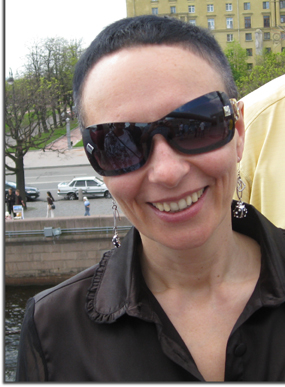 previously, as well as blocks and blocks of apartments. Elena
tried to explain the situation vis a vis government housing and
privatization. It was a lengthy discussion that involved lots of
swapping, and the interesting fact that even if you had a place you had
purchased, someone from 30 years ago could come back and claim it.
It seems that the national registration of individuals assigned a
specific address to each person or family. So if say, you
purchased a flat, someone who was assigned that flat in 1935, could come
back and claim it for their own. A bit crazy in my opinion.
As I stated, it was a lengthy discussion.
previously, as well as blocks and blocks of apartments. Elena
tried to explain the situation vis a vis government housing and
privatization. It was a lengthy discussion that involved lots of
swapping, and the interesting fact that even if you had a place you had
purchased, someone from 30 years ago could come back and claim it.
It seems that the national registration of individuals assigned a
specific address to each person or family. So if say, you
purchased a flat, someone who was assigned that flat in 1935, could come
back and claim it for their own. A bit crazy in my opinion.
As I stated, it was a lengthy discussion.
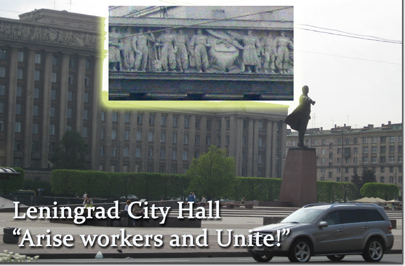 An
impressive building was that which was built in Stalin times as the
central St. Petersburg City (Leningrad) offices. The friezes were
impressive with the usual “workers following Lenin” sort of thing, but
we did not have time to stop. So it is a photo from a van window.
Note the friezes at the building's top. They are so atypical
Soviet carvings, with exhortations to "go forth for the good of the
Rodina." And of course, Vladimir Lenin is out in front, arm
outstretched, pointing the way.
An
impressive building was that which was built in Stalin times as the
central St. Petersburg City (Leningrad) offices. The friezes were
impressive with the usual “workers following Lenin” sort of thing, but
we did not have time to stop. So it is a photo from a van window.
Note the friezes at the building's top. They are so atypical
Soviet carvings, with exhortations to "go forth for the good of the
Rodina." And of course, Vladimir Lenin is out in front, arm
outstretched, pointing the way.
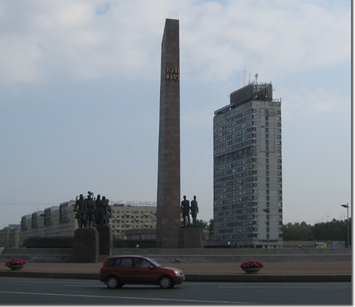 We
also missed the War Memorial, which celebrates the Siege of Leningrad.
I saw it previously, and it's a good
exhibit to attend if you are ever here.
We
also missed the War Memorial, which celebrates the Siege of Leningrad.
I saw it previously, and it's a good
exhibit to attend if you are ever here.
We continued on to Pushkin (formerly known as the Tsar’s Village).
This land was given to Catherine by Peter the Great, for a small house.
She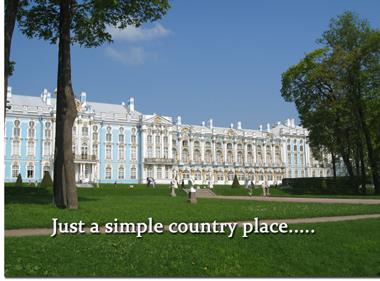 went
overboard and built a huge palace. This is the palace that was
used to house the German army in WW2 and was pretty much burned out at
the end of the war. It has been restored to all its former glory,
including the Amber Room. For those who don't recall, the Amber
Room is one of the world's great mysteries. The Germans spirited
the wall panels away, but they have
went
overboard and built a huge palace. This is the palace that was
used to house the German army in WW2 and was pretty much burned out at
the end of the war. It has been restored to all its former glory,
including the Amber Room. For those who don't recall, the Amber
Room is one of the world's great mysteries. The Germans spirited
the wall panels away, but they have
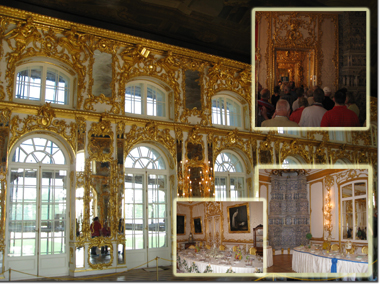 never
been recovered. So speculation is that all that original work lies
at the bottom of a sea/lake/mine, or is housed in a secret private
collection. No matters, as the Russians carefully reconstructed it
from original drawings and photographs. I tried to sneak a shot,
but the place is so dim, and you get jumped on by the babuskas if your
try to whip out your camera, so the only one I have is shaky, and not
worth showing. Go see it for yourself.
never
been recovered. So speculation is that all that original work lies
at the bottom of a sea/lake/mine, or is housed in a secret private
collection. No matters, as the Russians carefully reconstructed it
from original drawings and photographs. I tried to sneak a shot,
but the place is so dim, and you get jumped on by the babuskas if your
try to whip out your camera, so the only one I have is shaky, and not
worth showing. Go see it for yourself.
We had a very nice lunch in a hotel Pectopah (that’s the Russian visual
word for “restaurant”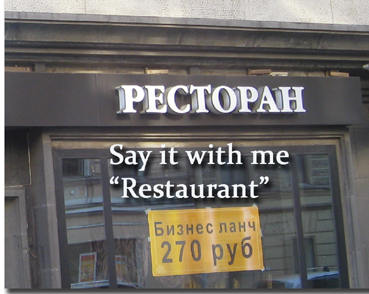 and is pronounced the same way "restaurant.")
and is pronounced the same way "restaurant.")
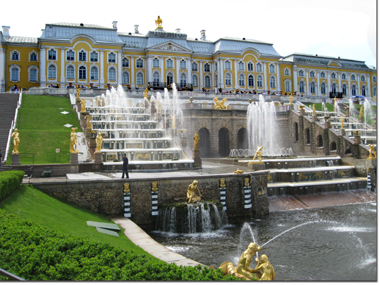 From
there it was a drive to Peterhof, or Peter’s Palace. Several of
us, including me, snoozed during the ride. We had intermittent
showers for the rest of the day, as we visited Peterhof and its gardens
and fountains. There are three cascading fountains, with the most
well know called The Grand Staircase. Peter had the staircase
connect to the Gulf of Finland, as his "path to the sea."
Interestingly, all the fountains are gravity fed. No
From
there it was a drive to Peterhof, or Peter’s Palace. Several of
us, including me, snoozed during the ride. We had intermittent
showers for the rest of the day, as we visited Peterhof and its gardens
and fountains. There are three cascading fountains, with the most
well know called The Grand Staircase. Peter had the staircase
connect to the Gulf of Finland, as his "path to the sea."
Interestingly, all the fountains are gravity fed. No
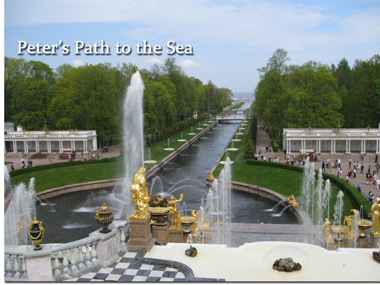 pumps
are involved, and the whole thing only flows from 11 AM to 4 PM, so the
tourists can see it. It's pretty remarkable that it is still
functioning after a hundred + years.
pumps
are involved, and the whole thing only flows from 11 AM to 4 PM, so the
tourists can see it. It's pretty remarkable that it is still
functioning after a hundred + years.
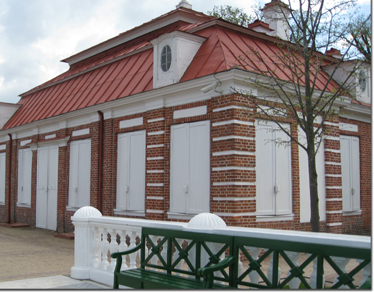 We
wandered a bit and visited the bath house, as well as Peter’s Castle.
This was a very simplistic yet charming palace right next to the Sea of
Finland. Peter preferred small, simple homes, to the grand ones of
the rest of the Russian nobility. Perhaps he didn't have
compensation issues!
We
wandered a bit and visited the bath house, as well as Peter’s Castle.
This was a very simplistic yet charming palace right next to the Sea of
Finland. Peter preferred small, simple homes, to the grand ones of
the rest of the Russian nobility. Perhaps he didn't have
compensation issues!
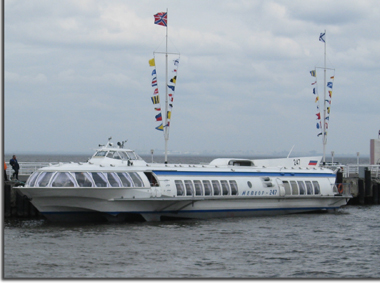
A hydrofoil ride back to St. Petersburg completed the day.
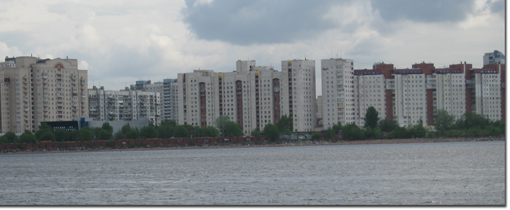 There
were blocks and blocks of apartments are along the shore. I wonder
if the water view costs more? We said our good-byes to Elena and Yuri,
and headed back to the ship.
There
were blocks and blocks of apartments are along the shore. I wonder
if the water view costs more? We said our good-byes to Elena and Yuri,
and headed back to the ship.
May 18
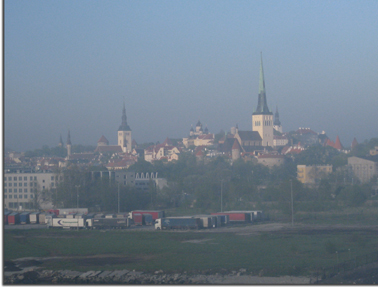 We
were again up and out at an early hour. The stop today was Talinn,
the capitol of Estonia. The mist covered city skyline appeared as
we pulled into the dock. This town was a major seaport for the
European trade routes, and as a result, has a great deal of German
influence. The German traders and wealthy lived on the hill in the
upper town, while the serfs lived in the lower portion. Much of
that still remains today, with a walled fortress; churches and old
building predominate in the upper town on Toompea Hill. In the 16th
century, the Swedes captured much of what is now Estonia, and placed
their Lutheran stamp on the people. In the early 1700s, Peter the
Great took control after the Northern Baltic War. The Germans
stayed and maintained Talinn as a trade center. The country stayed
under Russian control until the Bolshevik Revolution, but was ceded back
to Russia after WW1. The country
We
were again up and out at an early hour. The stop today was Talinn,
the capitol of Estonia. The mist covered city skyline appeared as
we pulled into the dock. This town was a major seaport for the
European trade routes, and as a result, has a great deal of German
influence. The German traders and wealthy lived on the hill in the
upper town, while the serfs lived in the lower portion. Much of
that still remains today, with a walled fortress; churches and old
building predominate in the upper town on Toompea Hill. In the 16th
century, the Swedes captured much of what is now Estonia, and placed
their Lutheran stamp on the people. In the early 1700s, Peter the
Great took control after the Northern Baltic War. The Germans
stayed and maintained Talinn as a trade center. The country stayed
under Russian control until the Bolshevik Revolution, but was ceded back
to Russia after WW1. The country
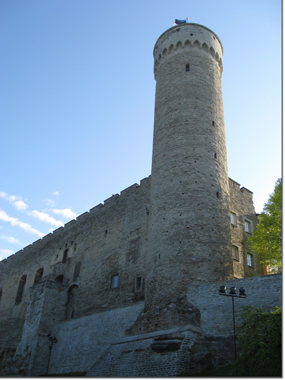 achieved
independent status in 1991.
achieved
independent status in 1991.
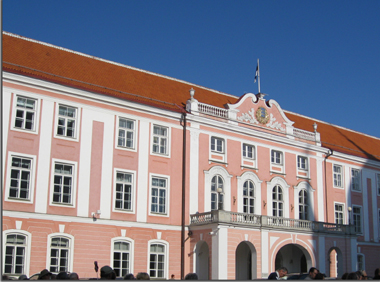
Visitors to the Hill will see the old Toompea Castle, the Parliament Building,
as well as St. Mary's Church.
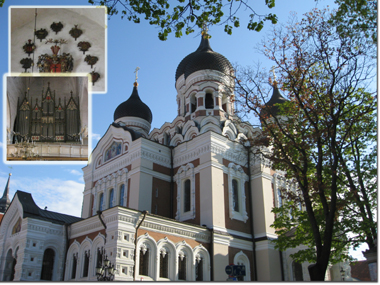 The
interior is well known for it's displayed coats of arms, as well as
internments for the nobility. Among the burial vaults in St.
Mary's Cathedral is one to Samuel Grieg, a Scotsman, who served with the
The
interior is well known for it's displayed coats of arms, as well as
internments for the nobility. Among the burial vaults in St.
Mary's Cathedral is one to Samuel Grieg, a Scotsman, who served with the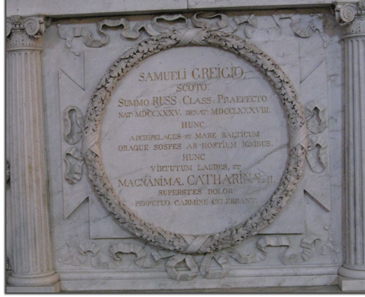 Russian Baltic Fleet. He was one of Catherine’s favorite lovers
and the tombs inscription reads to the effect that she will always weep
for him. It’s really rather lovely.
Russian Baltic Fleet. He was one of Catherine’s favorite lovers
and the tombs inscription reads to the effect that she will always weep
for him. It’s really rather lovely.
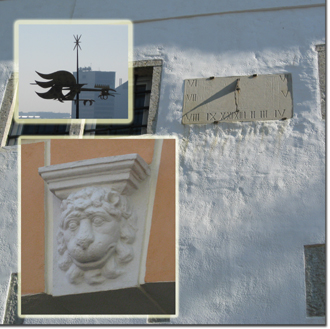 There
are many unique things to see here, from the weathervanes, to the
building decorations.
There
are many unique things to see here, from the weathervanes, to the
building decorations.
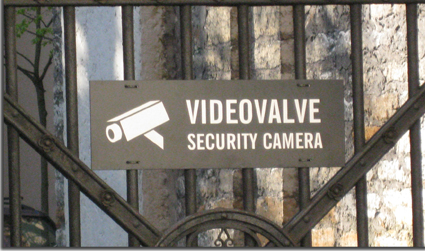
Of course, there are the ubiquitous gift shops, and a sign that I couldn't resist. Sort of supports Zeno's string theory of video!
Peter the Great had one of his simple palaces here. And as he
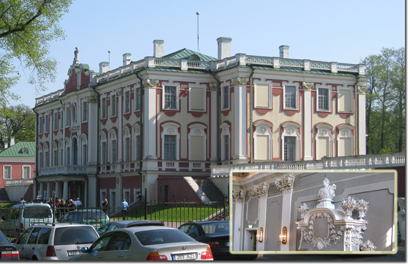 was
into smaller, less ostentatious palaces, the structure is pretty
ordinary. Surrounding it are older homes of the bureaucrats.
was
into smaller, less ostentatious palaces, the structure is pretty
ordinary. Surrounding it are older homes of the bureaucrats.
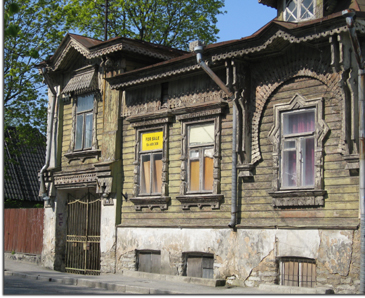 These wooden structures have been privatized, and while many are in
severe disrepair, many have been restored to their former livable
condition.
These wooden structures have been privatized, and while many are in
severe disrepair, many have been restored to their former livable
condition.
Talinn was a delightful place, with a mixture of old Soviet apartments,
Vienna style streetcars, and new cars, buildings and shops. Barb
and I blew off the Peter’s Palace tour and went and sat in a street café
and had coffee. There were plenty of young mothers and little
children wandering around, and as is customary in Europe, the kids were
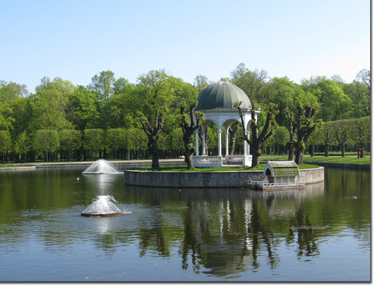 pretty
quiet. I wish I had been able to spend another half a day here.
Our guide said that the number of new, upscale cars in the street was a
response to the years of having nothing. Everyone was out to
impress every one else. Like most European countries, there is a
birth incentive and subsidized medical and education. The average
annual income is around US$11,000, with about 21% taxation, which is
less than the average US taxation rate.
pretty
quiet. I wish I had been able to spend another half a day here.
Our guide said that the number of new, upscale cars in the street was a
response to the years of having nothing. Everyone was out to
impress every one else. Like most European countries, there is a
birth incentive and subsidized medical and education. The average
annual income is around US$11,000, with about 21% taxation, which is
less than the average US taxation rate.
Unemployment is currently around 9%, and there is a good chance that the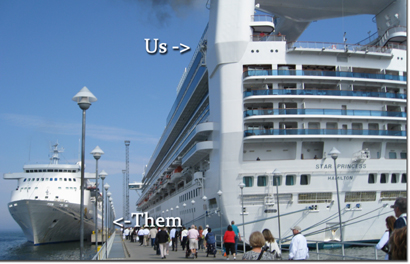 country will join the EU in the next several years. Talinn was a
delightful surprise.
country will join the EU in the next several years. Talinn was a
delightful surprise.
Another cruise ship was in when we arrived back for our early departure. You don’t realize how large the Star Princess is until you see a direct comparison. The fog set in as we left, and we are steaming along, tooting the foghorn, as we make our way to Gydinia, our port of entry to Gdansk, Poland.
May 19
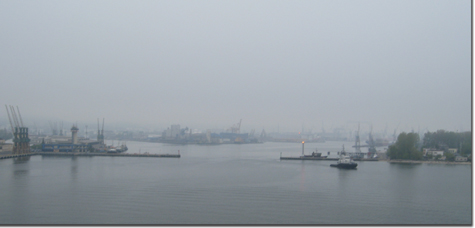 This
morning we arrived in the foggy port of Gdynia, which is the seaport
town closest to Gdansk, Poland. The intermodal loading
This
morning we arrived in the foggy port of Gdynia, which is the seaport
town closest to Gdansk, Poland. The intermodal loading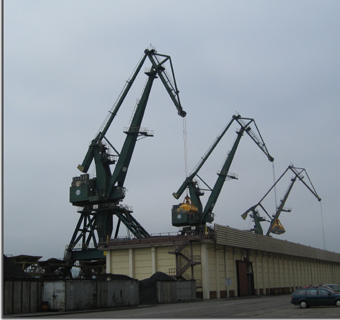 cranes stood like silent storks against the grey sky.
cranes stood like silent storks against the grey sky.
To set the stage here, we were to visit three connected towns in this
seacoast area; Gdynia (business),
 Sopot
(spa and relaxation), and Gdansk (tourism). So it was a march off
to the buses again. Can you guess the amenities that this bus
offers?
Sopot
(spa and relaxation), and Gdansk (tourism). So it was a march off
to the buses again. Can you guess the amenities that this bus
offers?
Our guide must have been a former school teacher, because she had a ton
of visual aids, including maps, photos, and examples of ration cards
from the Soviet times. For those of you unfamiliar with Poland,
the land has always served as a buffer between long time adversaries
Germany and Russia. As a result, the flat plains (which are
perfect for tank warfare) have been fought over for centuries.
Poland is now its own entity, and can claim a great deal of
responsibility for starting the break up of the Soviet dominion over the
satellite c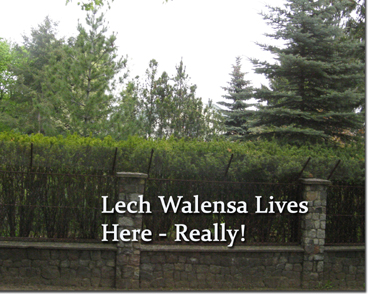 ountries.
This all started with the ship yard strike, which lead to a national
food strike and was lead by Lech Walesa back in the 1980s. He is a
revered figure here, and justly so in my opinion. His actions
changed the world. We drove slooooowly past his home, as we made
our way to the old town of Gdansk.
ountries.
This all started with the ship yard strike, which lead to a national
food strike and was lead by Lech Walesa back in the 1980s. He is a
revered figure here, and justly so in my opinion. His actions
changed the world. We drove slooooowly past his home, as we made
our way to the old town of Gdansk.
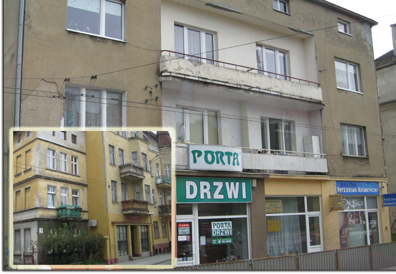
The city looked to be pretty much like any older European city, with
street trams (what we call light rail), and mixture of new buildings,
Soviet style apartment blocks,
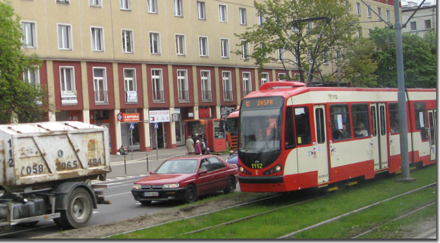 and
old, stucco covered brick homes. New cars abound, with the same
reason as we found in Estonia. And of course, there is plenty of
graffiti, which is so common here.
and
old, stucco covered brick homes. New cars abound, with the same
reason as we found in Estonia. And of course, there is plenty of
graffiti, which is so common here.
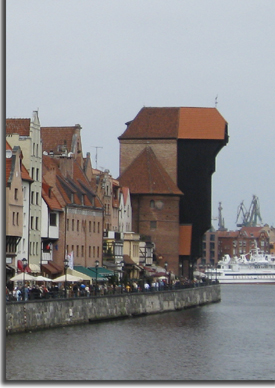
On our way to the old town, we stopped by a canal and took a look at the remaining structure of what was once the largest lifting crane in Europe.
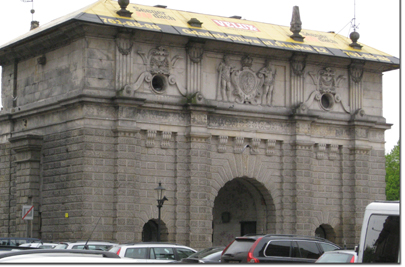
Anchored at both ends by the original city gates, the old town has been restored and is a major tourist area. So the place was loaded with shops. There are plenty of places to eat, and more importantly for the tourist trade, to shop.
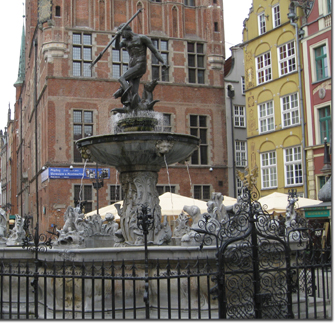 The
area is centralized around Neptune’s Fountain, and as I said, anchored
at both end by gates from the old, walled city.
The
area is centralized around Neptune’s Fountain, and as I said, anchored
at both end by gates from the old, walled city.

The buildings originally were residences of German businessmen, and if you note the number of windows, you’ll see that some structures have more than others. This is because there was a window tax; more windows, more tax, the better off you were.
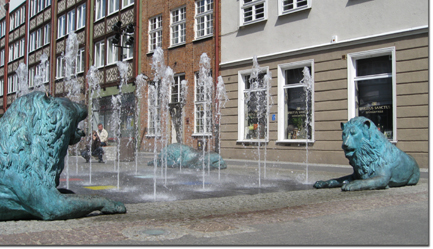 There
were some surprises to be had on the side streets, including this
delightful fountain being guarded by lions. Barb was pleased.
There
were some surprises to be had on the side streets, including this
delightful fountain being guarded by lions. Barb was pleased.
This is a major outlet for amber (Baltic Gold). Most of the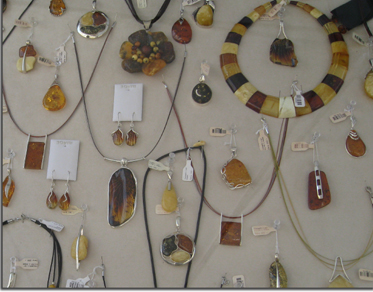 world’s amber is found in this area. Amber it is fossilized pine
tree sap, is surface mined about 200 feet below ground level and is
found in many colors. The mines are fairly ecological, or so we
were lead to believe, so who knows.
world’s amber is found in this area. Amber it is fossilized pine
tree sap, is surface mined about 200 feet below ground level and is
found in many colors. The mines are fairly ecological, or so we
were lead to believe, so who knows.
In the area of special surprises, visitors should look closely at the friezes and reliefs on the structures. I inquired if the nature of the display had anything to do with the original purpose of the structure (fish for a fish market, grapes for wine, etc). but was told that these were strictly decorative in nature.
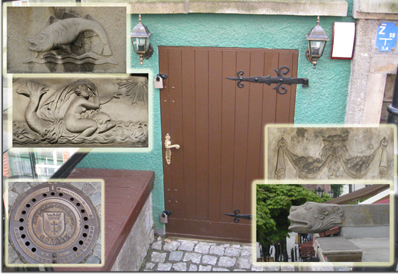
 There
was free Wi-Fi through the area, so we made use of that while we chilled
and had a cup of coffee. If you haven't figured it out, that is perhaps
one of my favorite things to do in places like this: just have a
coffee or a beer, and watch the people stream past.
There
was free Wi-Fi through the area, so we made use of that while we chilled
and had a cup of coffee. If you haven't figured it out, that is perhaps
one of my favorite things to do in places like this: just have a
coffee or a beer, and watch the people stream past.
On our return to the ship we stopped in Sopot for a look at the longest
wooden pier in all of Europe. Apparently this is a big deal, and we
took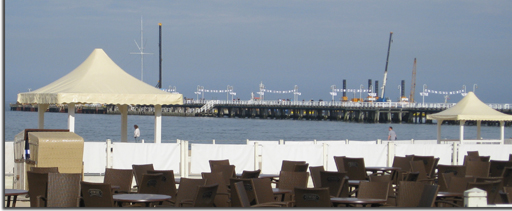 the opportunity to stick our hands in yet another sea, the Baltic.
the opportunity to stick our hands in yet another sea, the Baltic.
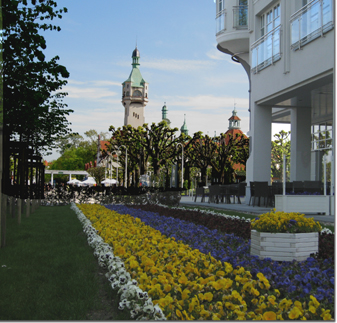 There
was some church or castle beside one of the grand hotels, but I can’t
remember what it was, but it did make a nice photo. My impression of
Gdansk was that it was growing, but still had a few crumbling edges.
Poland is a member of the EU, and the life expectancy is climbing.
Judging from the number of children, birthrates must be up as well.
As is typical here, medicine is subsidized, as is education. We
got back to the ship in time for dinner at the buffet, which was a first
for the cruise. You really can eat your way through this thing!
The evening culminated with a spirited game of Manipulation until
midnight. Tomorrow we are again “at sea.”
There
was some church or castle beside one of the grand hotels, but I can’t
remember what it was, but it did make a nice photo. My impression of
Gdansk was that it was growing, but still had a few crumbling edges.
Poland is a member of the EU, and the life expectancy is climbing.
Judging from the number of children, birthrates must be up as well.
As is typical here, medicine is subsidized, as is education. We
got back to the ship in time for dinner at the buffet, which was a first
for the cruise. You really can eat your way through this thing!
The evening culminated with a spirited game of Manipulation until
midnight. Tomorrow we are again “at sea.”
May 20
I was up early, and even though most of the passengers are still in bed at 5:30, there are a few wandering around and some in the buffet. The morning of our second day at sea was taken up with an interview with the captain, a well spoken Englishman, who went to sea at 16 years of age. As he put it, someone said that, “Those who go to sea are unfit to live on land.” This was followed by a brief show put on by the chefs and the wait-staff (230 of them on board) from the three main dining rooms. We attended a lecture on Oslo, our stop tomorrow.
A
highlight was watching the ship go under the Oresund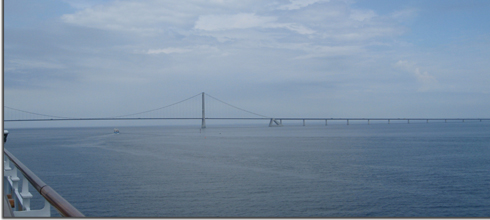 bridge which connects Copenhagen and Malmo. This structure goes
down as one of the longest bridges in the world, and was only opened in
2000. The length is
7,845 m (25,738 ft) and the bridge covers half the distance between
Sweden and the Danish island of Amager. The bridge supports two
railway tracks beneath four road lanes in a horizontal girder extending
along the entire length of the bridge.
bridge which connects Copenhagen and Malmo. This structure goes
down as one of the longest bridges in the world, and was only opened in
2000. The length is
7,845 m (25,738 ft) and the bridge covers half the distance between
Sweden and the Danish island of Amager. The bridge supports two
railway tracks beneath four road lanes in a horizontal girder extending
along the entire length of the bridge.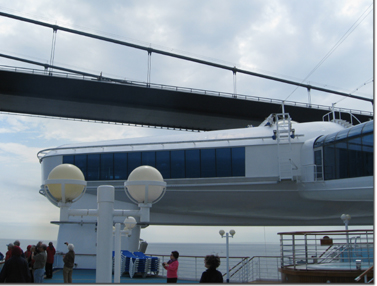
We made it under with 5 meters to spare.
I took a nap, and then it was off to dinner as the eating contest continued. We all needed a nice, quiet day.
May 21
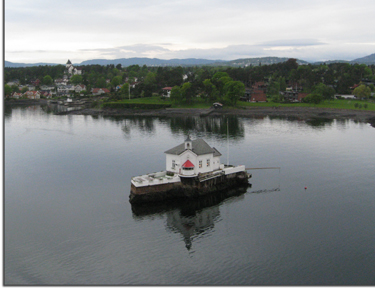 Early
this morning we entered the Skagerrak, which is the fjord inlet to Oslo,
Norway. The country has about 3% unemployment, is clean,
Early
this morning we entered the Skagerrak, which is the fjord inlet to Oslo,
Norway. The country has about 3% unemployment, is clean,
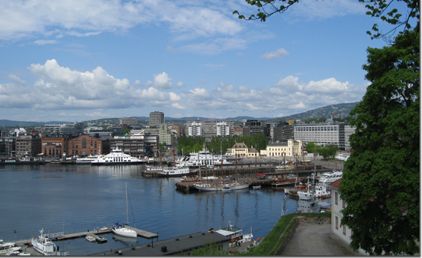 and
is roughly the size of New Mexico. Due to North Slope oil, the
place has a lot of cash, But that didn't lower the cost of
living. Oslo is the third most expensive city in the world, behind
Tokoyo and Moscow. A cup of coffee goes for about US$8. Needless
to say, we did not hang around in any street cafes.
and
is roughly the size of New Mexico. Due to North Slope oil, the
place has a lot of cash, But that didn't lower the cost of
living. Oslo is the third most expensive city in the world, behind
Tokoyo and Moscow. A cup of coffee goes for about US$8. Needless
to say, we did not hang around in any street cafes.
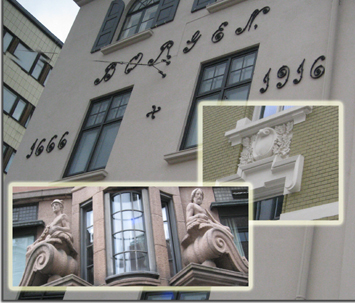
One thing I enjoy about old cities is the building decoration. Unlike today, with straight lines, the older edifices display character in their decoration.
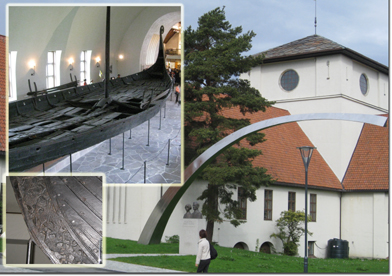 Our
bus tour today was the Best of Oslo, and that included the Viking ship
museum, where several of the old ships were on display. I must say
that these old Viking guys had a great deal of courage to cross the
Atlantic and roam as far as the Mediterranean in these little boats.
The didn't have much freeboard, but they certainly were broad of beam.
So the boats must have rode the waves like corks! These particular
ships were found, buried in blue mud, and have been cleaned up and put
on display. Interestingly, the Russ Viking tribe moved up through
central Europe, banding with some Slavic tribes. From them, we get
the name, Russia. Plus the Vikings made voyages to the Americas.
So in short, they got around.
Our
bus tour today was the Best of Oslo, and that included the Viking ship
museum, where several of the old ships were on display. I must say
that these old Viking guys had a great deal of courage to cross the
Atlantic and roam as far as the Mediterranean in these little boats.
The didn't have much freeboard, but they certainly were broad of beam.
So the boats must have rode the waves like corks! These particular
ships were found, buried in blue mud, and have been cleaned up and put
on display. Interestingly, the Russ Viking tribe moved up through
central Europe, banding with some Slavic tribes. From them, we get
the name, Russia. Plus the Vikings made voyages to the Americas.
So in short, they got around.
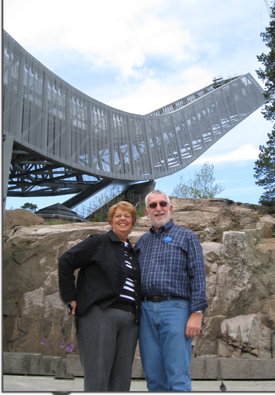
The old Oslo money stays in town, but the new money is on the hillside, which in my opinion has a better view of the harbor. We drove past these homes to reach the newly refurbished ski jump. John and I took the simulator ride so we had an exciting jump, as well as a downhill ski run. Like they say about flying: "Hours of boredom, coupled with seconds of terror."
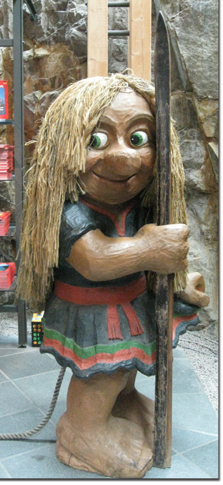 Of
course, Norway is famous for trolls, and no visit would be complete
without at least one picture of the mythical creatures.
Of
course, Norway is famous for trolls, and no visit would be complete
without at least one picture of the mythical creatures.
Next stop -
Vigeland Park. Gustav Vigeland was a sculptor who
studied under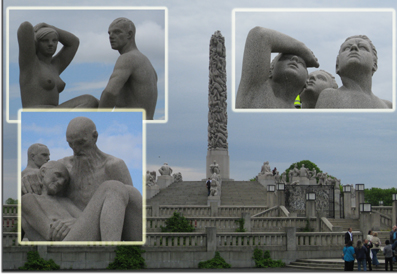 Rodin, in the early 20th century. He died in the middle
of the 1940's, and there are some in Oslo who have said that if he had
lived longer, the entire town would be a mere garden for his work.
As it is, these statues are confined to a large park in the middle of
the town. These bronze and stone sculptures represent the cycle of
Rodin, in the early 20th century. He died in the middle
of the 1940's, and there are some in Oslo who have said that if he had
lived longer, the entire town would be a mere garden for his work.
As it is, these statues are confined to a large park in the middle of
the town. These bronze and stone sculptures represent the cycle of
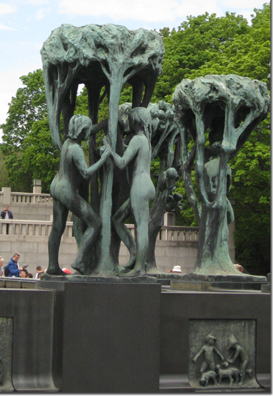 life,
and are quite well known.
life,
and are quite well known.
The crying baby, love, old age, birth, youth – all are represented here in a lovely park.
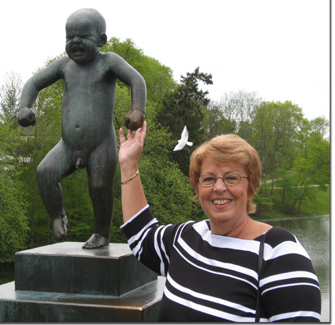 It is supposed to be good luck to touch the hand of the angry baby.
It is supposed to be good luck to touch the hand of the angry baby.
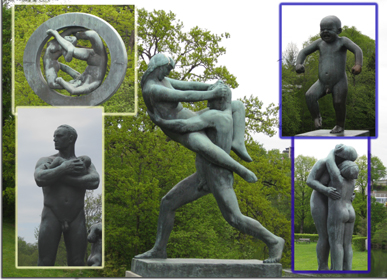
Then we hopped off the bus in town and walked through the old Akershus Castle on the way back to the ship.
Our time here was too short, and we departed at 1400.
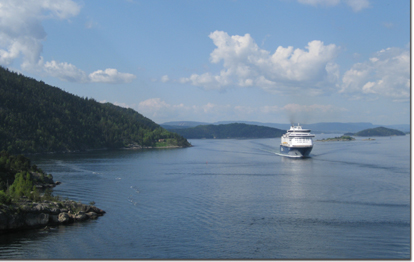
Along the way, we passed the Norwegian fort that took out a German cruiser at the start of WW2. On 9 April 1940, Germany sent a force up the fjord to capture Oslo. This action was known as the Battle of Drobak Sound. The shore defenses scored something like 21 out of 22 rounds fired on a brand new German heavy cruiser, the Blucher, sending it to the bottom. Oil still leaks from the wreck. Unfortunately, we did not see any as we passed the wreck site. An interesting anecdote to the action was that the Norwegian guns were 280mm guns from Krupp.
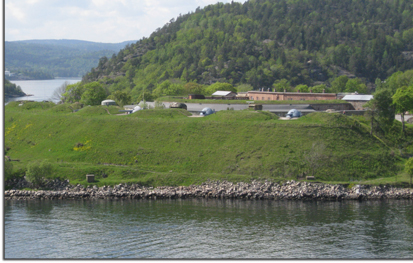
It was a gorgeous sight as we sailed down the narrow fjord to the open Baltic Ocean for our final run to Copenhagen. That will be the end of the trip.
May 22
We arrived to a foggy Copenhagen. We dragged our feet getting off the ship. I must say that Princess has the people handling down to a science. Departure was easy, and luggage was easily located on the dock. We had to leave before our scheduled cab pickup time, but our driver, Ivan, showed up a little early, so all was good. We checked into the hotel, and walked a bit. The rain (actually a downpour) during our visit 10 days ago turned into beautiful sunny day this time.
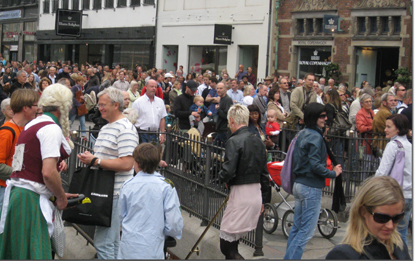
Today was the start of Pinsedag Holiday Weekend. In the rest of the world, it is more commonly known as Whit Sunday, or the weekend after Pentecost. So there were throngs of people out enjoying the day.
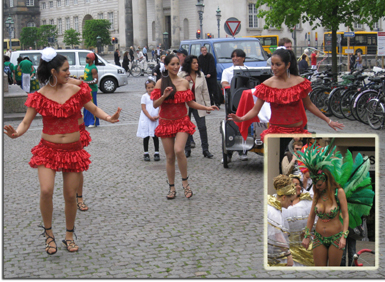
In the City Hall Square, Carnival was also being celebrated, with scantily clad dancers and lots and lots of music. We walked to the Canal and Nyhavn Street down a pedestrian mall with lots of very high end shops.
We did a canal trip, which certainly opened up some different visual
areas of the city, but the narrator was difficult to understand.
However, we did a get a new perspective on the city,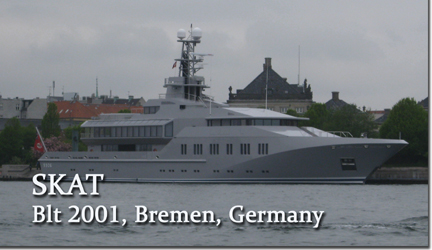 including the Skat, a luxury yacht owned by Charles Simonyi, a
former software engineer from Microsoft. The ship is 71 meters in
length, and is the 64th largest in the world.
including the Skat, a luxury yacht owned by Charles Simonyi, a
former software engineer from Microsoft. The ship is 71 meters in
length, and is the 64th largest in the world.
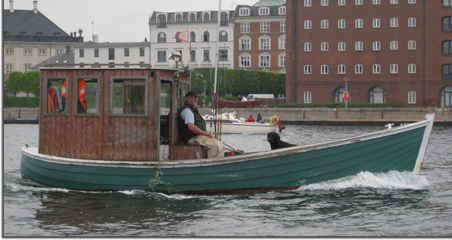
I wondered if the owner was having as much fun as the owner of this personal watercraft, complete with man's best friend and faithful companion.
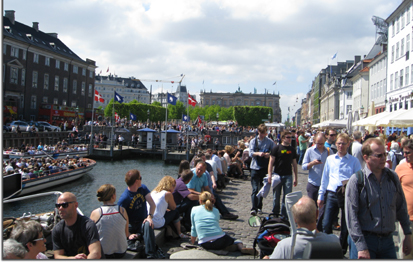
We had lunch in a street cafe on Nyhavn street by the canal which was
crowded with people. Bill & I tried Gammel Dansk, a liqueur
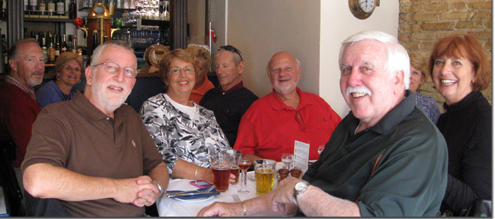 which
basically means “Old Danish.” It actually tasted like old Danes
had walked through it barefooted, so it must be an acquired taste.
which
basically means “Old Danish.” It actually tasted like old Danes
had walked through it barefooted, so it must be an acquired taste.
We walked back to Tivoli Gardens. This is a famous amusement park
right in the middle of
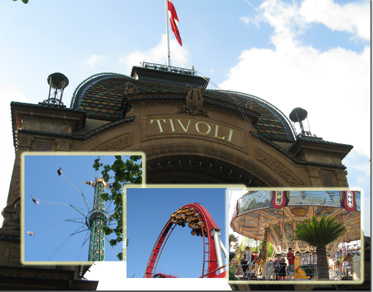 town.
There are beautiful gardens, restaurants, and some pretty amazingroller
coasters, and other rides.
town.
There are beautiful gardens, restaurants, and some pretty amazingroller
coasters, and other rides.
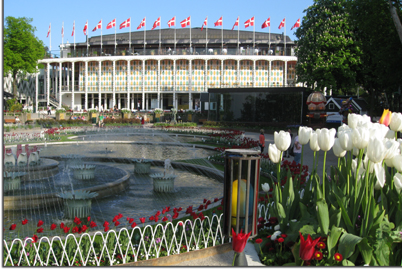 We
wandered a bit, but the restaurants were crowded.
We
wandered a bit, but the restaurants were crowded.
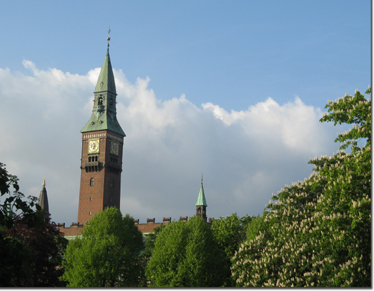
Some of us went back to the hotel and spent our final night in a sidewalk café. It was a nice, relaxing way to end the trip.
May 23
It was a twelve hour flight back to Milwaukee – ten on the hop to Atlanta and a short connect to catch the Milwaukee flight. That latter flight required a rather mad dash through Hartsfield, as we had to move from an international terminal to a domestic one. And of course, the gates were located as far as possible down the concourses. But we made it. And were met in Milwaukee by a limo driver holding up a card with our name. How cool! We had a wonderful time, met some great people, and saw a new part of the world. Reflecting on the trip: cruising is definitely an easy way to travel and see a lot in a relatively short period of time. However, you don't get a feeling of the culture of the countries, but you get a taste and a desire to go back to see more. As always, it is good to be home.